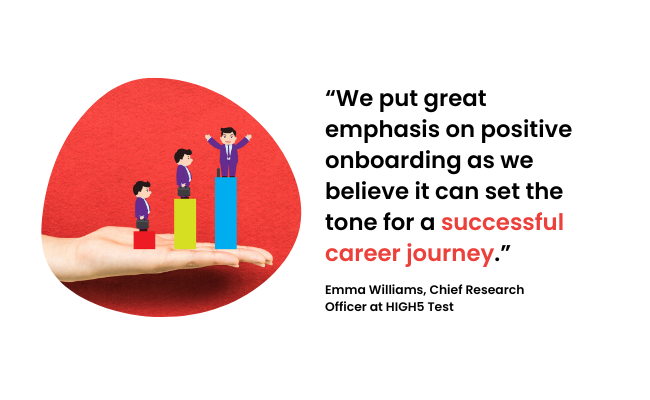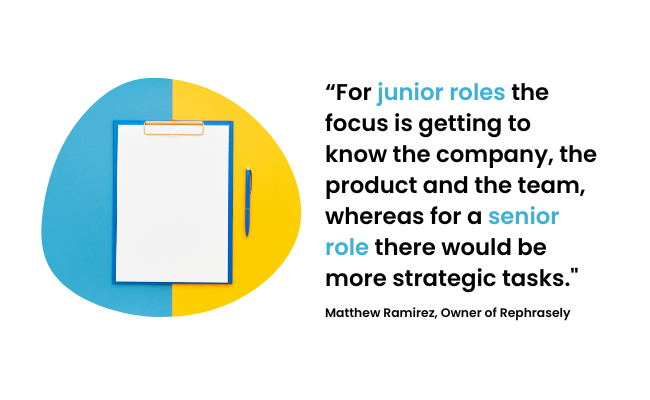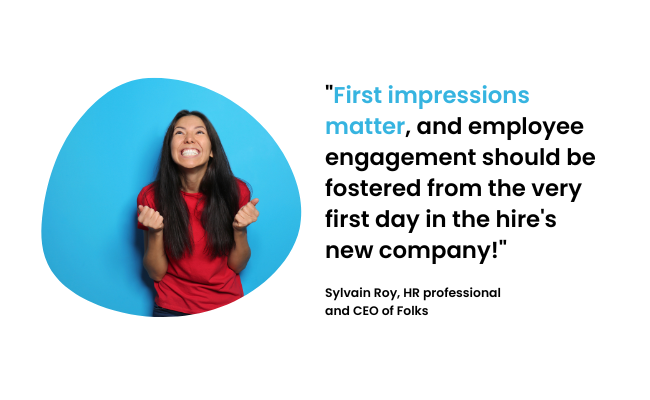
We ask industry experts for their tips when it comes to a good onboarding process and onboarding best practice.
Onboarding is a crucial part of your employee lifecycle.
It can be incredibly powerful when you consider the full lifecycle of your people.
As Emma Williams, Chief Research Officer at HIGH5 Test said, “We put great emphasis on positive onboarding as we believe it can set the tone for a successful career journey.”

But understanding your onboarding process and streamlining it can be tricky.
You’re likely battling lots of different requirements across teams, multiple tools and processes and many different stakeholders.
That’s a lot of pressure. And it’s made worse by the fact that onboarding is so widely recognised as being important to business function.
Sylwia Smietanko, HR Specialist & Recruiter at Passport Photo Online said, “A well-conducted onboarding is exceedingly crucial, I think, because first impressions truly matter.
“The employee gets a good idea of what kind of company they’ve joined, what the future’s got in store for them, and if it’s a place they’d want to stay for a bit longer. A bad onboarding experience will no doubt make the employee way more disconnected and more likely to jump ship if the opportunity presents itself.”
Centralising all of this can be overwhelming.
But, that’s where we come in. In this blog, we’ll go through:
- What is onboarding
- Why onboarding is important
- Onboarding best practices
- How to onboard a new employee
Let’s get started.
What is onboarding?
Onboarding is a process used by a business to assimilate a new starter. It usually contains a number of tasks, meetings and processes that the current team and new hire need to go through in order for the new employee to feel ready to begin their job.
Related: Read our complete guide to onboarding
Onboarding is a key part of hiring a new employee and transforming them from a new hire to a highflyer.
How long does onboarding usually take?
We asked a group of experts in L&D and HR for the inside scoop on their onboarding process and we found the average onboarding process takes 2 weeks.
However, they also specified that they expect it to take 3 months on average before a new employee is capable of doing their job completely independently.
Related: 20+ shocking onboarding statistics you need to know
Leah Ward, People Strategy Consultant at Seedling Stage said, “I design formal onboarding programs to last 1-3 weeks depending on the size of the company and complexity of the role or product offering.
“While basic onboarding tasks will be completed within the first week, training and learning experiences can take a few weeks to complete.”
How many tasks should form part of your onboarding?
Again, there was variety in answers when we asked our L&D experts for their insights on how many tasks should form your onboarding process.
On average, new hires are given between 10 and 40 tasks to complete as part of their onboarding.
Maria Harutyunyan, Co-Founder at Loopex Digital said, “we have a checklist of around 30 items that we cover during onboarding. This might seem like a lot, but we believe in being thorough.
“We cover everything from setting up email accounts to introducing new hires to their team members. We want to make sure that our new hires have everything they need to succeed in their new roles.
Matthew Ramirez, Owner of Rephrasely added, “For a more junior role the tasks may be more focused around getting to know the company, getting to know the product, and getting to know the team, whereas for a more senior role there may be more of a focus on setting goals and objectives, as well as broader strategic topics.”

Can you do onboarding digitally?
Remote onboarding is a common challenge for L&D and HR professionals.
But it doesn’t have to be. We found that 60% of onboarding processes happen digitally. While some professionals used digital tools for all of their onboarding processes, most seemed to use a mix between digital and traditional.
Digital and face-to-face onboarding have their advantages.
Karolina Kijowska, Head of People at PhotoAiD said, “the digital onboarding process allows us to streamline and automate administrative tasks, such as filling out forms and signing documents.
“It also provides a consistent and standardized experience for all new employees, ensuring that they receive the necessary information and training to start their job effectively.
“But, as I said, it also brings drawbacks like the lack of face-to-face interaction, which can make it difficult to establish a personal connection with the new hire.”
Grace He, People & Culture Director of teambuilding.com added, “Virtual offices lack many barriers to switching employment in in-person workspaces, since employees can take other interviews mid-work day, switch jobs with virtually no change to their work environment or routine, and may feel distant from co-workers.
“When employees enter the organization feeling welcomed and well-informed about what’s expected of them and how they fit into the larger picture, they are far more likely to stay with that company instead of leaving after just a few months because they feel misunderstood or unsupported.”
Why is onboarding important?
There are multiple reasons why onboarding is important to a business function. Some key ones are improved employee retention, greater capability and better business results.
You can read more on its impact in our complete guide to onboarding.
We also asked our experts for their opinion.
Here’s what they had to say.
Sarah Watson, Chief Operating Officer at BPTLAB said, “Key benefits of proper onboarding include faster employee integration into the company culture, reduced time to productivity, and better employee retention.”
Sylvain Roy, HR professional and CEO of Folks agreed saying, “One key benefit of effective onboarding processes is that we noticed that our employees stay in our company in the long run. First impressions matter, and employee engagement should be fostered from the very first day in the hire’s new company!”

Meanwhile, Jon Morgan, CEO at Venture Smarter said, “One key benefit of doing onboarding well is that it can help new hires feel more engaged and productive in their roles from the start.
“By providing them with the information, resources, and support they need to hit the ground running, we can minimize the learning curve and help them feel confident in their abilities to contribute to our company’s success.”
Onboarding process best practices
Now we know a bit more about what onboarding is and how it can support your business goals, let’s look at some best practices to consider when building out your onboarding process.
We asked our team of experts for their insight and this is what they said:
Create cohorts
It’s not possible for every team as it depends on the scale of your hiring at the time, but pooling new hires into cohorts is a great way to better manage the onboarding process.
It allows those doing the tasks, i.e. having meetings with new hires, to bunch them together. And it gives new hires an opportunity to create a bit of camaraderie with other employees as they’re quite literally, in the same boat.
Break down what’s important
But the first step is to break down what onboarding is and where to focus your attentions.
As Aleksandar Ginovski, Product Manager at Enhancv said, “there are two distinct parts to the onboarding process: the initial onboarding phase, which lasts for a few days or weeks, and the ongoing onboarding phase, which can last for several months.”
Splitting these into two separate processes can help you better build out your structure.
Related: The ideal onboarding checklist
Build in exciting moments
We know onboarding doesn’t scream excitement, but there’s a lot of interesting research out there into the role adrenaline plays in retention.
While you might not be looking into adrenaline-junkie experiences like skydiving as part of your onboarding process, you still want to find something that is felt not just read, or heard.
You might consider gamification, such as a scavenger hunt. Or you might up the social engagement by looking at a competition or quiz.
💡Pro Tip
As premium partners of Totara, we know the Importance of social collaboration. It can be a strong driver of employee engagement and advocacy.
Learn more about Totara Perform and its role in an LMS.
Give a one-to-one focus
Sometimes, people need time and attention to truly understand something. Whether that’s your business structure, your product or service or their goals.
Emma Williams, Chief Research Officer at HIGH5 Test said, “we prioritise individualised coaching sessions with the leader or mentor of the new hire for a smoother transition into the company culture.”
Providing a mentor or coach Is a common way to better Improve relations within the company and gives new hires someone they know and trust to go to with problems.
💡Pro Tip
We’ve created our own tool to better manage and report back on mentoring relationships.
Learn more about ThinkLink
Curate the flow of information
Have you ever seen some organisational decks where they have overlapping information, or go into far too much detail at the wrong time?
Simplify your information and give people the right content, at the right time.
It can be easy to go into information overload. But really boil down what your new hire needs to know at what point.
You can add more detail later. Don’t overwhelm them and give them what they need to ensure the burden is off them from an information-gathering perspective.
How to onboard a new employee
Onboarding doesn’t have to be a complicated process.
With the right tools in place, you can reduce the manual labour for both your new hires, and your HR teams.
Think Learning helps its customers create learning environments for their people through innovative tools. We support a range of clients with their onboarding needs so that they can easily onboard new hires and support them through their employee lifecycle.
Learn more about Think and the tools it has by booking a demo with our team. We’ll show you how to improve your onboarding processes from start to end.

